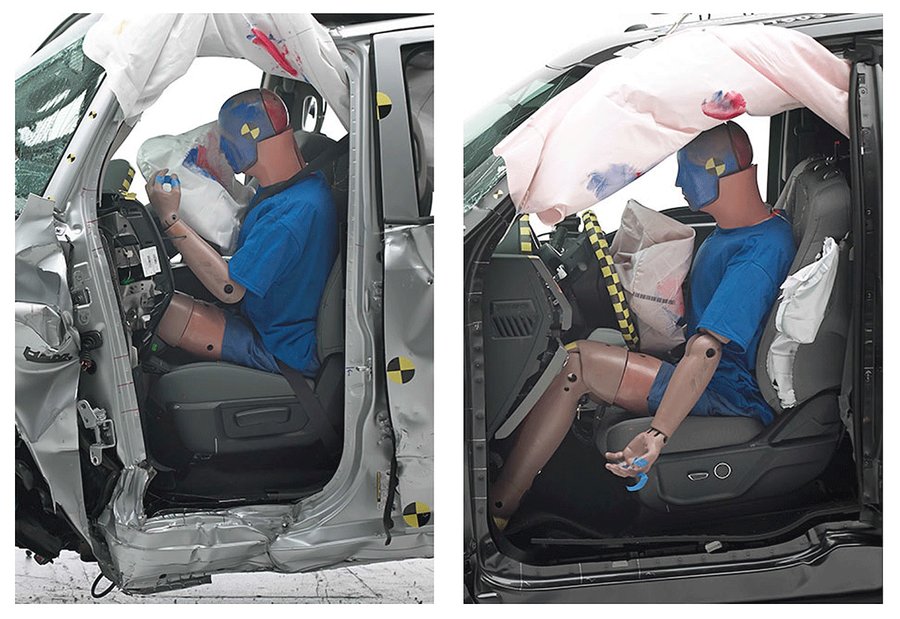Ford F-150 Leads Pickups In IIHS' Corner Crash Tests

The truck earned the rating after receiving crashworthiness upgrades following a shaky performance last year.
Despite their reputation for ruggedness and durability, many other full-size pickups struggled to hold up to the IIHS crash test. The IIHS released the results today.
The latest small-overlap tests were the first that examined both crew cab and extended-cab or double-cab variants of full-size pickups from multiple automakers, and it found disparities between the body styles.
Double-cab models of the Chevrolet Silverado 1500 and Toyota Tundra were rated “acceptable,” the IIHS’ second-best rating, while crew cab models of both trucks were one notch lower, at “marginal.” The Silverado’s results extended to its twin, the GMC Sierra 1500.
The IIHS said that unlike their double-cab counterparts, the Tundra CrewMax and Silverado Crew Cab models saw “considerable” intrusion into the occupant compartment that “compromised survival space” for the driver.
The tests by the insurer-funded group are designed to show what happens to a vehicle’s structure and its occupants when its front corner strikes another vehicle or a stationary object like a tree. They have proved challenging for automakers, which have had to re-engineer the front ends of their vehicles to better absorb an off-center impact and reduce the risk of intrusions into the passenger compartment.
Ram 1500 Quad Cab and Crew Cab models both earned a “marginal” overall rating, which took into account a “poor” rating - the IIHS’ worst - for their structure.

Ford rating
The F-150's good rating combined with Ford’s optional forward collision's warning system to give the F-150 SuperCab the only “Top Safety Pick” designation among the pickups included in this batch of IIHS tests. The F-150 SuperCrew received the designation earlier.
Ford said its truck development team created 31 safety-related innovations for the F-150, including new structures to manage crash forces and joining methods tested with supercomputer simulations.
“We spent thousands of hours engineering, designing and developing multiple safety features that work together in the event of an accident,” Raj Nair, Ford’s executive vice president for global product development, said in a statement.
A Toyota spokeswoman noted that the Toyota trucks tested meet or exceed federal safety standards. “We are evaluating the test results with the goal of finding new ways to continuously improve the performance of Toyota trucks and to further enhance the safety of our vehicles,” she wrote in an email.
A Chevrolet spokesman declined to comment on the results.
Updated tests
The IIHS decided to begin testing the extended-cab configurations after learning from Automotive News that the 2015 F-150 SuperCrew -- which aced the small-overlap test last year -- had crash-protection features that weren’t present on other versions, including wheel blockers, which are tubular steel assemblies welded to the frame in front of and behind both front wheels.
A subsequent test of the SuperCab model gave it a “marginal” rating, leading the IIHS to say that the disparity “shortchanges” some Ford F-150 buyers.
For the 2016 model year, Ford responded by installing protections in the SuperCab and regular cab editions, earning praise from the IIHS. A Ford spokesman said that wheel-blocker assemblies, plus reinforcements to the truck’s rocker panels and door hinge pillars, were added to all 2016 F-150s.
“Ford is leading the way among large pickup manufacturers when it comes to protecting people in a range of crashes and offering technology to warn drivers of imminent frontal crashes,” Raul Arbelaez, vice president of the IIHS’ Vehicle Research Center, said in a statement. “We commend Ford for taking last year’s test results to heart and upgrading protection for SuperCab occupants in small overlap crashes.”
Trapped legs
With the improvements, the F-150 was the only truck among those tested to shield occupants from “moderate to severe” intrusion into the driver footwell.
Dummy measurements from the competing trucks indicated that “serious” lower leg, ankle and foot injuries would be likely to result from such a crash, according to the IIHS.
“Drivers in these pickups would need help freeing their legs from the wreckage following a small overlap crash,” Arbelaez said in a statement.
Among them, the two body styles of the Ram 1500 performed worst, measuring up to 17 inches of intrusion into the footwell.
The Ram’s passenger compartments were also compromised in the test. The Ram’s door-hinge pillar, instrument panel and steering column were pushed back toward the driver, the IIHS observed. The head of the driver dummy slid off the left side of the deployed airbag as the steering column shifted to the right, causing the head to move near the intruding A-pillar, the group found.
The Ram 1500’s current generation launched in 2012, the same year the IIHS began subjecting vehicles to the small-overlap crash, while the current generations of other trucks debuted later.
Last year, Fiat Chrysler Automobiles said it would adopt crash countermeasures similar to Ford’s to improve the crashworthiness of its 2016 Ram pickups.
In a statement, an FCA spokesman said 2016 Ram 1500s tested by the IIHS were equipped with “impact-mitigation devices,” but declined to specify what they were.
“Our vehicles are designed for real-world performance, and no single test determines overall, real-world vehicle safety,” the FCA spokesman said. “Every FCA US vehicle meets or exceeds all applicable motor-vehicle safety standards.”
Related News
